 We have cider!
We have cider!Spent the holiday Friday getting the press finally limbered up. After a week of cleaning and finishing the new pressing tray, and on a whim refinishing some of the other press wood, which added another day's delay, Friday came and I was *ready* -- at least mentally -- for that cider.
Went to slide the new tray into the press, gave it a push and -- oof. It stuck. No worries, hand built wooden press, imperfect tolerances, check to see that everything is aligned and -- no joy. That pressing tray was a solid eighth of an inch too big on one corner, and it just was not going to fit.
Sigh.
Out comes the ancient wooden Stanley plane; out came the little spoke shave, which proved more useful. Forty minutes of judicious trimming and sanding later, the pan now fits. But of course the finish is compromised, and so although we are talking about a three inch strip, it has to be refinished. Which means two coats, four hours apart and another twelve hours to cure to food-safe. Sigh, again. Saturday we really will press cider.
Saturday Cider Day -- At Last!
The press is assembled; Leslie is in the house sterilizing bottles, the kids are washing and culling apples, and soon it will be cider.
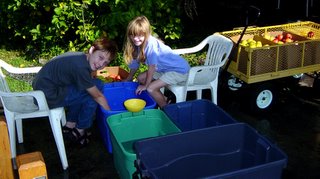 The washing process gets all the stems and dirt and leaves, but also any agriculture residues. Fortunately, about a third of our apples are organic, so that helps. And these came straight from the orchard, before they could be sprayed in waxes or oils to make them look pretty, so we don't have to wash quite so hard to get that off. But they are seconds, and so we have to cull the few with rotten spots, and those with open holes, or cuts.
The washing process gets all the stems and dirt and leaves, but also any agriculture residues. Fortunately, about a third of our apples are organic, so that helps. And these came straight from the orchard, before they could be sprayed in waxes or oils to make them look pretty, so we don't have to wash quite so hard to get that off. But they are seconds, and so we have to cull the few with rotten spots, and those with open holes, or cuts.The cuts can (and often do) breed mold and bacteria, but these can often be removed. Similarly, a small hole on the outside generally means that a critter has moved in, and spoiled s
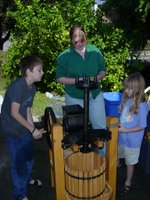 ome or all of the apple. Out of four bushels, we had about a half bushel of "suspect" apples, and out of that wound up with about two gallons of rotten fruit and cut off bits. Not bad at all.
ome or all of the apple. Out of four bushels, we had about a half bushel of "suspect" apples, and out of that wound up with about two gallons of rotten fruit and cut off bits. Not bad at all.The big kids took turns feeding apples into the grinder and turning the grinder crank. The crank can be hard work, although the fly-wheel helps keep it rolling. Every so often an apple would get jammed in just right or one sibling would joyfully feed too many apples to crank, bringing the cranker to a stand still. Eventually it came down to the adults to finish the cranking.
Sometimes, the apple-feeder would forget to feed the apples, watching, in fascination, as the "apple eater" grinder chopped away at a whole apple. It
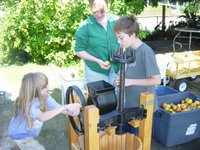 only takes one reminder each year that the apple-eater eats fingers too. (Wicked grin.) Watching a very solid apple slowly vanish as it is turned to mush is a good reminder too.
only takes one reminder each year that the apple-eater eats fingers too. (Wicked grin.) Watching a very solid apple slowly vanish as it is turned to mush is a good reminder too.Once the ground apples were ground, the kids (and then the adults) took turns turning the screw that pressed the cider.
This year, we bottled gallons -- in part to deliver several to my mom, and in part because we only did four bushels. The bottling process involves swapping out the metal pan under the press for an empty one, an
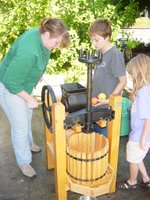 d walking the cider, carefully, over to the funnel in the gallon jug. We do pour the cider through sieve to trap large apple bits, and any other debris that might have gotten into the catch-bowl. But 99.9% of the suspended apple solids go right into the bottle.
d walking the cider, carefully, over to the funnel in the gallon jug. We do pour the cider through sieve to trap large apple bits, and any other debris that might have gotten into the catch-bowl. But 99.9% of the suspended apple solids go right into the bottle.In years past we have pressed a 50-50 of Granny Smith and Red Delicious. The cider was darker than even unfiltered store bought, and pretty darn sweat.
This year's cider came out of the press even darker, a rich cinnamon brown. Really dark. To the degree thatin a certain light it looked like a jug of coffee. The flash in these photos lightened it up a great deal, but here it is compared to Trader Joe's unfiltered apple juice. And most people consider that a little dark!
Out of four bushels we pressed about 8 gallons, drank most of a gallon during pressing and gave four to my mom. Not a bad yield, but not as high as we sometimes get.
Still, we have cider!
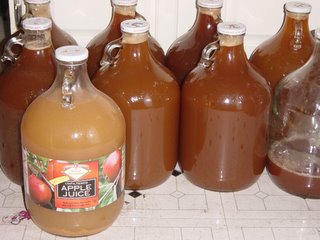
No comments:
Post a Comment